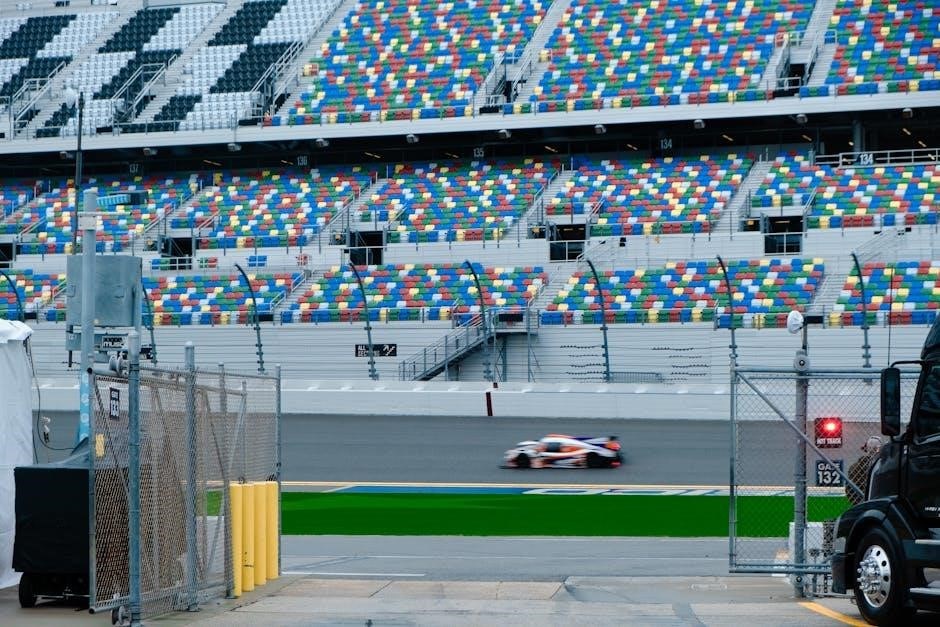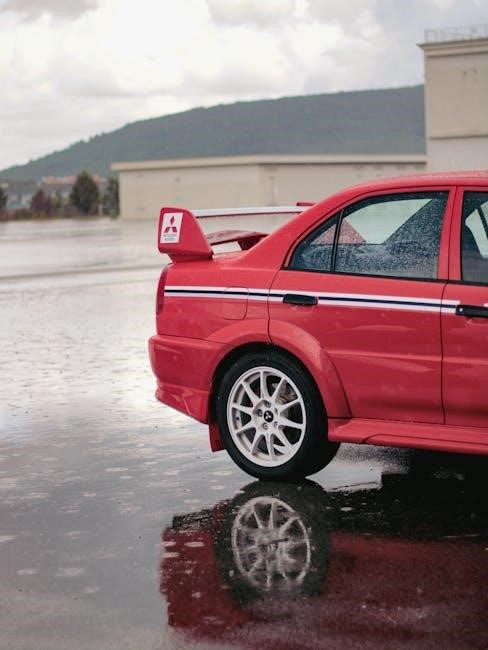
grassroots motorsports tire guide
Discover the essential guide for optimizing tire performance in grassroots motorsports, covering key choices, maintenance, and strategies to enhance your driving experience on both track and street.
1.1 Understanding the Importance of Tires in Grassroots Motorsports
Tires are the most critical component in grassroots motorsports, directly impacting grip, handling, and safety. They serve as the only contact point with the road, influencing acceleration, braking, and cornering performance. Choosing the right tires can significantly enhance lap times, driver confidence, and overall racing experience, making them a cornerstone of both track and street driving success.
1.2 Overview of Popular Tire Choices for Track and Street Use
Popular tire choices for grassroots motorsports include options like the Bridgestone Potenza RE-71RS, Maxxis RC-1, and Goodyear Eagle RS. These tires offer a balance between grip, durability, and affordability, catering to both track and street use. They are DOT-approved, ensuring street legality, while delivering exceptional performance for autocross, HPDE, and track days, making them versatile for enthusiasts seeking optimal results.

Tire Classifications and Ratings
Tire classifications and ratings, such as the 200tw rating, play a crucial role in determining performance, grip, and durability for grassroots motorsports, ensuring optimal street and track use.
2.1 What is the 200tw Rating and Its Significance
The 200tw rating signifies a tire’s treadwear grade, indicating durability and performance. Higher ratings mean longer life, while lower ratings offer superior grip, crucial for grassroots motorsports where balance between speed and longevity is key. This rating helps drivers choose tires suited to their driving style and track conditions, ensuring optimal performance and safety.
2.2 DOT-Approved Tires: Street Legality and Performance
DOT-approved tires meet federal safety standards, ensuring street legality while offering impressive performance. They balance durability for daily driving with enhanced grip and handling for track days, making them versatile for grassroots motorsports enthusiasts. While not ideal for extreme racing, they provide a practical solution for those needing tires that excel in both everyday and high-performance contexts.
Popular Tire Options for Grassroots Motorsports
Explore top tire choices for grassroots racing, including Bridgestone Potenza RE-71RS, Maxxis RC-1, and Goodyear Eagle RS, known for their performance, handling, and durability on track and street.
3.1 Bridgestone Potenza RE-71RS: Features and Performance
The Bridgestone Potenza RE-71RS is a top-tier choice for grassroots motorsports, offering exceptional grip and handling. Its advanced tread compound and asymmetric design deliver consistent performance on both track and street. DOT-approved, it balances durability with high-speed capabilities, making it ideal for autocross and track days while maintaining street legality and driver confidence.
3;2 Maxxis RC-1: A Budget-Friendly Option for Track Days
The Maxxis RC-1 offers an affordable yet high-performance solution for grassroots motorsports enthusiasts. Designed for track days, it features a soft compound for maximum grip and responsive handling. Its durability and consistency make it a favorite among budget-conscious drivers, providing excellent value without compromising on performance, making it an ideal choice for those seeking cost-effective tire options for track use.
3.3 Goodyear Eagle RS: Balancing Grip and Durability
The Goodyear Eagle RS is a versatile tire that excels at balancing grip and durability, making it a strong contender for grassroots motorsports. Its advanced tread compound ensures consistent performance on both track and street, while its robust construction enhances longevity. Designed for enthusiasts seeking a reliable tire that delivers sharp handling and traction, the Eagle RS is a practical choice for drivers who demand performance without sacrificing durability.
Budget-Friendly Tire Options
Explore budget-friendly tire options for grassroots motorsports, including the Maxxis RC-1 and used tires, offering affordability without compromising performance, durability, and quality for track and street use.
4.1 Affordable Alternatives for Beginners
Beginners can explore budget-friendly tires like the Maxxis RC-1, offering excellent grip and durability at a lower cost. These options provide a balance of performance and affordability, making them ideal for those new to grassroots motorsports. They ensure safety and reliability while keeping expenses manageable for track days and street use.
4.2 Used Tires: Pros and Cons for Grassroots Racing
Used tires can be a cost-effective option for grassroots racing, offering significant savings. However, their history and condition are often unknown, which may lead to hidden damage or uneven wear. While they can be environmentally friendly, safety and performance risks exist. Always inspect used tires carefully and consider their origin before purchasing for track or street use.
Tire Maintenance and Care
Proper tire maintenance is crucial for optimal performance and longevity. Regular inspections, proper storage, and avoiding extreme temperatures ensure durability. This enhances safety and overall performance.
5.1 Tips for Extending Tire Life on the Track
Regularly inspect tires for wear and damage to ensure optimal performance. Proper inflation, avoiding extreme temperatures, and storing tires in a cool, dry place can significantly extend their lifespan. Consistent driving techniques and avoiding aggressive maneuvers also play a key role in maintaining tire longevity on the track.
5.2 Importance of Tire Pressure and Alignment
Proper tire pressure ensures optimal grip, handling, and even tread wear, while correct alignment prevents uneven wear and improves stability. Regular checks and adjustments are crucial for maximizing performance and extending tire life. Neglecting these can lead to premature wear and reduced control, emphasizing their vital role in both safety and efficiency on the track.
The Role of Wheel Alignment in Tire Performance
Proper wheel alignment ensures optimal tire contact, improving handling, reducing uneven wear, and enhancing performance. Misalignment can lead to poor traction and accelerated tire degradation.
6.1 How Proper Alignment Affects Handling and Tire Wear
Proper wheel alignment ensures even tire contact, enhancing handling and stability. Misalignment can cause uneven wear, reducing traction and shortening tire life. Correct alignment optimizes performance, improves safety, and maximizes tire durability, making it a critical factor in both street and track driving scenarios for grassroots motorsports enthusiasts.
6.2 Adjusting Alignment for Different Racing Conditions
Adjusting wheel alignment is crucial for optimizing performance in various racing conditions. For wet conditions, increase negative camber for better grip. In dry conditions, reduce camber for stability. Toe alignment can be tweaked for sharper handling in autocross or stability in high-speed track days. Proper adjustments enhance handling, reduce tire wear, and improve overall performance tailored to specific racing scenarios.
Suspension Setup and Its Impact on Tires
Suspension setup directly influences tire behavior, affecting handling, grip, and wear. Proper tuning enhances performance, stability, and tire longevity, ensuring optimal contact with the road or track surface.
7.1 Understanding the Relationship Between Suspension and Tire Behavior
The suspension system plays a crucial role in determining how tires perform. It influences load transfer, camber angles, and tire contact patches, all of which affect traction, handling, and wear patterns. Properly tuned suspension ensures consistent tire behavior, maximizing grip and minimizing uneven wear, which is essential for both street and track driving efficiency.
7.2 Tuning Suspension for Optimal Tire Performance
Tuning your suspension involves adjusting components like springs, dampers, and anti-roll bars to enhance tire contact and handling. Stiffer springs and proper damping help maintain tire grip, while adjustments to camber and toe alignment optimize contact patches and reduce wear. Balancing these elements ensures improved stability and performance, whether on the street or track, by maximizing tire effectiveness and driver control.
Driving Techniques to Maximize Tire Performance
Mastering braking, acceleration, and cornering strategies enhances tire grip and longevity. Smooth inputs and adaptive driving styles based on tire compounds optimize performance and reduce wear.
8.1 Braking, Acceleration, and Cornering Strategies
Smooth braking and gradual acceleration prevent tire overheating, while precise cornering techniques maintain consistent grip. Adjusting driving style to tire compounds ensures optimal performance, reducing wear and improving lap times.
8.2 Driver Adjustments for Different Tire Compounds
Drivers must adapt their techniques based on tire compounds, as softer tires offer more grip but wear faster, while harder compounds last longer but provide less traction. Adjustments include earlier braking, smoother inputs, and precise throttle control to maximize performance and longevity, ensuring optimal tire utilization for varying track conditions and racing scenarios.

Comparing Tire Brands for Grassroots Motorsports
Explore key differences between major tire brands, focusing on performance, durability, and cost. Bridgestone, Maxxis, and Goodyear stand out, offering unique advantages for track and street use.
9.1 Key Differences Between Major Tire Manufacturers
Major tire brands like Bridgestone, Maxxis, and Goodyear differ in performance, durability, and cost; Bridgestone excels in grip and handling, while Maxxis offers budget-friendly track options. Goodyear balances durability with grip, and other brands like Michelin and Continental provide unique advancements in tire technology, catering to diverse driver preferences and racing conditions.
9.2 Brand-Specific Features and Technologies
Each brand offers unique technologies: Bridgestone’s Potenza RE-71RS features advanced tread compounds for max grip, while Maxxis RC-1 uses specialized rubber for consistency. Goodyear’s Eagle RS combines responsive handling with durability. Continental’s ExtremeContact series offers all-season versatility, and Michelin’s Pilot Sport tires are known for precise control, ensuring drivers can choose based on specific performance needs and preferences.

Grassroots Motorsports Events and Competitions
Grassroots motorsports events, like autocross and track days, offer enthusiasts a platform to test tires and refine driving skills in competitive yet accessible settings.
10.1 Local and National Events to Test Your Tires
Explore local autocross and national track days to evaluate tire performance. These events provide a platform for enthusiasts to test durability, grip, and handling in real-world conditions, fostering improvement and community engagement.
10.2 Preparing for Autocross, HPDE, and Track Days
Ensure your tires are in optimal condition for autocross, HPDE, and track days. Check tread depth, wear patterns, and pressure. Research the venue’s surface and weather to tailor your setup. Set realistic goals and practice techniques to maximize tire performance and safety, enhancing your overall racing experience.

Troubleshooting Common Tire Issues
Identify uneven wear, bubbles, or damage. Check tire pressure and alignment. Inspect for punctures or excessive wear, addressing issues promptly to maintain performance and safety.
11.1 Identifying and Fixing Uneven Tire Wear
Uneven tire wear often appears as feathering or excessive wear on edges. Check for improper alignment, worn suspension, or incorrect tire pressure. Inspect for uneven patterns, such as heel-toe wear or diagonal wear. Addressing these issues promptly can prevent further damage and improve handling. Regular tire rotations and proper alignment adjustments are key to maintaining even wear and extending tire life.
11.2 Diagnosing and Addressing Tire Damage
Inspect tires for cracks, bubbles, or uneven wear, which can indicate damage. Check tread depth and look for punctures or debris. For cuts or punctures, assess if repairs are feasible. Replace tires with severe damage. Regular inspections and proper storage can prevent issues. Addressing damage early ensures safety and optimal performance on the track or street.
The Future of Tires in Grassroots Motorsports
Explore advancements in tire technology, including eco-friendly materials and smart tires, set to revolutionize grassroots racing with improved performance, sustainability, and driver safety.
12.1 Emerging Trends in Tire Technology
Innovative materials like eco-friendly rubber compounds are enhancing grip and durability while reducing environmental impact. Smart tires with adaptive compounds offer real-time performance adjustments for varying conditions. Advances in tread design and manufacturing processes are improving efficiency and longevity. These trends promise to elevate grassroots motorsports by delivering better performance, sustainability, and cost-effectiveness for drivers at all levels.
12.2 Sustainability and Innovation in Tire Manufacturing
Tire manufacturers are embracing sustainability by incorporating recycled materials and eco-friendly production methods. Innovations like energy-efficient manufacturing processes and biodegradable compounds reduce environmental impact. These advancements ensure tires meet performance demands while promoting greener practices, benefiting grassroots racers who seek reliable, high-quality options that align with modern environmental values and cost-effectiveness.
This guide provides essential insights for selecting and maintaining tires, ensuring optimal performance and durability for grassroots motorsports enthusiasts, helping them make informed decisions to enhance their racing experience.
13.1 Recap of Key Takeaways for Choosing the Right Tires
When selecting tires for grassroots motorsports, prioritize understanding tire ratings like 200tw, ensuring DOT approval for street legality, and balancing grip with durability. Consider budget options and maintain proper tire care, including pressure checks and alignment. Additionally, explore driver techniques and suspension tuning to optimize performance. This guide equips enthusiasts with the knowledge to make informed decisions for their racing needs.
13.2 Final Tips for Optimizing Your Grassroots Racing Experience
Focus on driver skill development, tire management, and event preparation to elevate your grassroots racing experience. Regularly inspect tires for wear and damage, and ensure proper heating during track days. Stay updated on local autocross and HPDE events, and continuously adapt your techniques to different tire compounds and racing conditions for optimal performance and enjoyment.